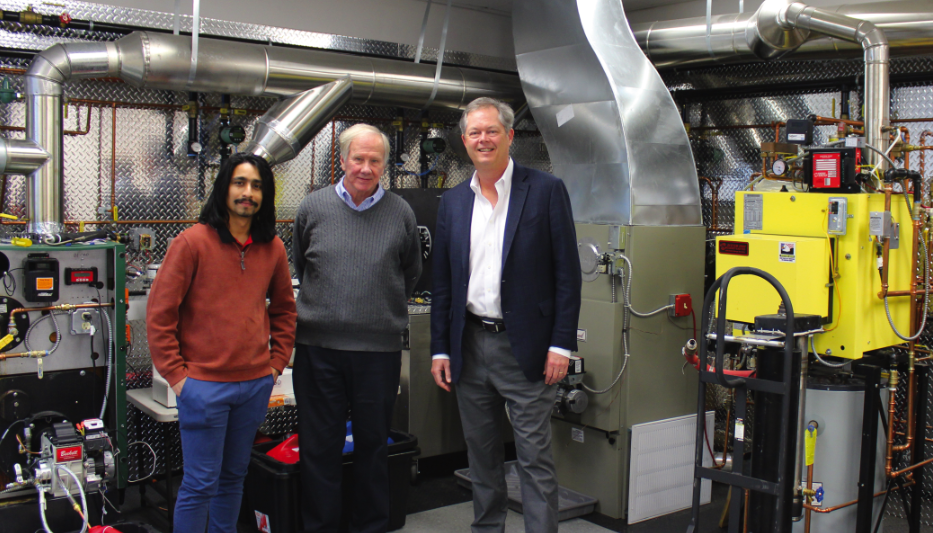All
The New NORA

Oil & Energy’s exclusive interview with NORA President Michael Devine
From outside, the NORA Liquid Fuels Research Center in Plainview, New York looks much like any of the hundreds of nondescript commercial buildings typical of the suburban roads just off the Long Island Expressway — offices, warehouses, big-box storefronts, etc. Nevertheless, inside the NORA lab at 131 E. Ames Court, an unassuming group of energy industry veterans and bright, young scientists are helping develop the heating fuels and equipment of the future.
Oil & Energy visited NORA last March to meet with Michael Devine, the organization’s new president. Devine officially assumed the role on March 1 following the retirement of John Huber, who had presided over the National Oilheat Research Alliance since its authorization by Congress at the turn of the 21st century.
To hear Devine tell it, John Huber and the organization he helped put together played no small part in ushering liquid heating into this century. “He helped put this industry in a place where we can take this next launching off point,” NORA’s new president said. As for the facility and those working inside, Devine said “it’s a credit to Dr. Tom Butcher and his team that our lab and organization are thought of as cutting-edge for helping new technologies make their way to market.”
In addition to a laboratory filled with green fuels and heating equipment donated by industry supporters, the NORA Research Center houses a classroom where technical training is offered in conjunction with the New York State Energy Coalition as well as a conference room where business and association leaders can meet with NORA officials. It was here that NORA President Michael Devine spoke with Oil & Energy last March. We were joined by Dr. Butcher, who discussed some of the organization’s latest research efforts and afterward led us on a tour of the lab.
Oil & Energy would like to thank Michael Devine, Tom Butcher, and the entire NORA team for making this article possible and for all that they do on behalf of our readers across the liquid heating fuel industry.
Can you tell us about your background in the heating oil and biodiesel industries?
Michael Devine: Sure, Sam. I grew up in the heating oil business. When I got out of college, I went to work for our family business, Devine Brothers, and since I wasn’t qualified to drive a truck, I worked pulling the hose. After a while, I drove the truck and worked in the field as an apprentice tech for a year, moved into sales and management, and finally had the opportunity to run our family business for about 7 years.
During that time, we were having success in other facets of our business but growing our heating oil business was problematic. There was a lot of direct consumer marketing in Fairfield County, Connecticut, and it seemed to become a choice of margin or customer attrition. The status quo wasn’t working. In 2003, I received a postcard from the National Biodiesel Board (NBB) proclaiming this new, renewable fuel, biodiesel, which came from American soybean oil, could be blended into heating oil and burn identically. At the time there were great concerns about U.S. oil imports and the price of the barrel. So, I went out to the first National Biodiesel Conference in Palm Springs, California. There were about 200 people there, everyone from ADM to individuals making biodiesel in their garage.
When I returned, I made the decision that we were going to bring biodiesel into Connecticut and start blending it into heating oil. Over a three-year period, we doubled the size of our retail business as Bioheat started to take off. We were one of the first adopters in the U.S. Subsequently, we changed the name of our heating oil division to Devine Bioheat and it brought a lot of success. Then in 2009, I decided to go out on my own and dive deeper into the renewable fuels industry, so I created Earth Energy Alliance and NBB became my first key client.
I worked for three years as a petroleum liaison with Paul Nazzaro and as a technical adviser for states, helping to communicate to policymakers what this new fuel was and why it was beneficial for the environment. At that time, I befriended a lot of association executives and technical experts such as Dr. Butcher who was then at Brookhaven National Lab. NYOHA and others were advocating for B2 mandates in New York City, so we relied on Dr. Butcher to help us to understand the technical properties of biodiesel and what if any changes were going to be required.
Tom Butcher: It’s funny how cautious we were at the start about the blend level. “You can’t go over 5%!”
MD: We were all learning together, but that’s how the industry started. Working with NBB, I got to know a lot of producers and saw an opportunity to immerse myself in distributing biodiesel, so I entered an agreement with AMERIgreen Energy, and through these collaborations we made the business case to encourage a couple biodiesel producers to enter into tank leases in New York Harbor. We then built a distribution platform for biodiesel to move through New York City, Long Island, Connecticut and Massachusetts. This required not only selling the fuel but helping educate owners, executives and frontline technicians. We were passing along lessons learned in our company and helping the heating oil community in New York utilize blends at B20. It really was a village of advocates that helped to grow that space in the early days.
In 2018, I found myself looking for another opportunity. Fortunately, I had developed a long relationship with Gene Gebolys, CEO and owner of World Energy, and Gene asked if I would come aboard and help take some of the lessons learned with B20 out to California. We began blending 20% biodiesel with 80% renewable diesel and created an RD80/B20 blend, essentially a 100% renewable transportation fuel. Based on the carbon reductions associated with these fuels, we developed commercial agreements with companies like FedEx, UPS, Ryder, the Union Pacific Railroad and other regional entities in California. These experiences provided me with unique insight into the power of a Low-Carbon Fuel Standard market as well as a broader view of liquid renewables as a whole.
Along with your experience, what do you hope to bring to your new role? Why did you want to be president of NORA?
MD: First, let me say that we all owe a huge debt of gratitude to John Huber. Over 22 years, he created this organization with the help of many other individuals and shepherded it in a brilliant way to get us to where we are today, bringing our team together, working through several reauthorizations of NORA, and pivoting from largely consumer marketing to a stronger focus on research and development. He helped put this industry in a place where we can take this next launching off point. That’s a credit to John and the way he was the caretaker of these precious resources.
As far as how I came to this opportunity, I had the pleasure to serve on the NORA Board in the Executive Committee and received the email that John was retiring. To be honest, I was not thinking about myself for the role. It wasn’t until I received a call from a friend to ask me if it was something I would consider that I looked at the job description and thought, ‘Wow, NORA really wants to focus more on renewable fuels.’ As I thought about the opportunity more, I realized my skill set and experiences might be very valuable directionally, so I applied.
The process went on for several months. Along the way, I learned more about NORA and became more enthusiastic. I started to have a sea change mentally from looking at what I’d done commercially, having had success building programs throughout my career, to the transition of a personal advocation for this industry that I grew up in. As somebody who understands firsthand what a lot of our dealers and wholesalers are going through, I was thrilled and humbled when I was offered the job.
You mentioned your board experience with NORA. Would you tell us a little bit more about your involvement with the group over the years?
MD: In getting to know a lot of the state execs over the years, as my roles and career path changed, the friendships we gained were always maintained. So, from time to time I’d get a call from an executive saying, “We’re working on a biodiesel initiative. Can you take some meetings with us?”
Over the years, John Huber and I were seeing each other more frequently at conferences, and NORA was very interested in the renewable fuels opportunities to transition oilheat. I think John and NORA thought it would be beneficial to have a renewable fuels producer with oilheat experience serve on the board. I went on the NORA Executive Committee and looked at my role as being one to share what’s happening in the renewable fuels space commercially and how it might affect heating oil. It was important for me to be a good resource to the heating oil industry.
At the same time, I was serving as a Governing Board member of NBB and on the board of MEMA as well. Even as I was doing more work out west, I never left the heating oil industry and never wanted to leave.
What are some of NORA’s current major activities?
MD: I was talking with John and Tom earlier about the evolution of NORA, how it’s pivoted from consumer education to research and development. So, I’ll let Tom talk about what he’s working on here with our team.
TB: NORA Research is focused on two things: energy efficiency and the industry’s transition to biofuels. Both are really challenging and important. In the area of efficiency, trying to improve heating systems’ winter and summer integrated performance is an issue that we’ve found to be really important. As advanced controls become available, they are helping us achieve very high efficiencies. One of the biggest changes I’ve seen over the last few years, and that our work helped drive, is a dramatic increase in the efficiency with which domestic hot water is produced in summertime.
Another important thing we’ve been doing is working with PriMedia and others on analysis of the energy savings associated with NORA Rebates. This is a great program offering small cash incentives to help encourage homeowners to upgrade their systems, and the effect has been huge with some 6,000 homes participating. We’ve gotten, for many of the sites, detailed data on fuel delivery before and after equipment upgrades and then through analysis determined their weather-corrected energy savings. It’s a pretty impressive story. On average, we’re seeing over 20% annual savings and when we translate that to gallons, dollars, and greenhouse gas emissions saved, it’s a set of accomplishments to be proud of. There’s a report on it on the NORA website, and that program is going to continue.
We’re also now extending that analysis to oil-heated homes where heat pumps have been installed. We’re looking at that data to understand the impact heat pump installation — be it a small mini-split or a whole-house ducted system — has on annual fuel consumption. We’re finding so far that impact is smaller than we thought it would be, so we’re going back to try to understand why folks are maybe not using these heat pumps for heating. We’re looking for more sites we can use for analysis, and this includes information about what kind of heat pump was installed, a good year of fuel consumption before the installation, and a good year afterward.
In the area of biofuels, that’s a major undertaking, and the goals we’ve set for ourselves are really high. We want to be sure there are no technical barriers in the way of the industry accomplishing its transition from fossil fuel to biofuels, so we want to address all aspects of biofuel use: delivery, storage, long-term stability, potential interaction with metals, elastomer seal materials, and of course combustion performance. I think the overall story is quite good, and increasingly we’re seeing pioneers using blends up to B100.
Thanks, Tom. Michael, what would you like to accomplish during your first year as president?
MD: Having served on the NORA Executive Committee, I wasn’t quite as educated on all of the programs and benefits that NORA provided, and I wondered if I was alone in that. Part of what I’ve been doing in my first weeks is talking to some of the members of the Executive Committee, and I think some of them are in the same boat. That’s of nobody’s fault – NORA does a lot of great work here on Long Island.
So, I see this as an opportunity to get out — now that, God willing, we’re on the other side of COVID — and visit associations, speak, listen, and see as many distributors, wholesalers and industry partners as I can. I want to talk about NORA from a one-on-one standpoint about what we do and offer. Some state associations do a really great job in helping to communicate that, but not everybody. In the next year or two, we all would like to make sure we are communicating with our dealers and wholesale partners, as well as listening to their suggestions and concerns.
Tom and I are also looking to contribute as thought leaders to organizations where efficiency rules are being written. We want to provide facts around our higher efficiency equipment and the improved environmental benefits our advancing industry has seen by blending renewable fuels. Today at NORA, we see our responsibility as making sure we can be a great voice for this industry through our technical projects, research and development initiatives, and offering the industry educational and certification programs, which provide young people opportunities to build a strong future career pathway in our field. When the time comes and a customer is thinking about making a change to their heating systems, NORA can help offset that expense by providing rebates through the distributors and keep that customer comfortable with high efficiency liquid heating.
We are fortunate to have a great team at NORA. Along with Tom and myself, we have Director of Education Bob O’Brien, research engineers Neehad Islam and Ryan Kerr, and senior industry consultants John Levey and Richard Sweetser. Our team is going to be out in the field, in the classrooms and visiting state associations to openly communicate what NORA is working on for the betterment of our industry.
How do you see NORA aiding the industry in its transition to renewable liquid heating fuels?
MD: I think it’s essential. Having marketed biodiesel for almost 20 years, the two questions a retail customer would typically have were what’s the price difference between this and standard heating oil, and what’s this new fuel going to do to my heating system. NORA has nothing to do with the cost of the fuel, but everything to do with the operational integrity of that system. Tom, Ryan, Neehad and Bob are performing research and development for both public and private NDAs on behalf of several equipment manufacturers. We’re thrilled to be able to do that, and it’s a credit to Tom and his team that our lab and organization are thought of as cutting-edge for helping new technologies make their way to market.
As we look at the different types of biofuels — biodiesel, ethyl levulinate, renewable diesel, or whatever else might come to market — I think it’s essential that NORA is on the forefront, testing, looking for issues to address, adjustments, blends, all the things that wholesalers and retailers will question. We want to make this transition as easy as possible because Tom and his team have done the work up front to make it so. Our role in the research and development of these fuels encompasses all the technical aspects to make sure they come to market and work seamlessly in our heating equipment.
One thing I know from experience in California is that change can happen very quickly. If, for example, all heating fuels had to reduce carbon by 50%, from our standpoint, that’s not a ‘lock the door’ situation. The testing we are currently conducting could allow us to pivot to renewable diesel-biodiesel blends and perhaps for EL to come to the surface. NORA is thinking ahead and testing future fuels so we can assure the retail heating oil company and their customer that these fuels meet and in some cases exceed operational expectations.
None of us have a crystal ball, but could you speak about where you see NORA and our industry going next, specifically in terms of the scenario described above?
MD: The world is moving quickly to decarbonize, and that’s a good thing. Over the last two days we saw REG purchased by Chevron and a 50-50 collaboration of Neste and Marathon on their Martinez, California plant. Where for some time there was almost an adversarial, competitive relationship, we’re now seeing renewables and traditional integrated oil working together, and that is the move to decarbonize. A lot of refiners look at the current energy landscape and realize if they don’t strive to decarbonize, they won’t be around very long.
I look at our space as one that can decarbonize. The work Tom and his team are doing allows liquid heating a pathway to not only survive but to grow. Now some readers might think, ‘Oh, Devine’s lost his mind!’ No, I really think we can grow. It’s going to be difficult for other energy sources to decarbonize in the way that liquid heating fuels can. We have been much quicker to embrace the transition to decarbonize voluntarily through the Providence Resolution and going back to the work Tom did at Brookhaven.
You don’t turn on a dime, so I think the work we’re doing can enable our industry to be ready and to grow if a scenario like that becomes reality. As far as some of the technical projects, I’ll let Tom touch on what we might be working on looking forward.
TB: We’ve spent a lot of time focusing on B20, and folks are now using it in different regions. We field tested B50 and are finding that some folks are starting to roll out B50 to a large number of customers on a regular basis. The frontier for us is now B100 so we’re really going all the way. We’re engaged now in a field test on B100 and working with standards bodies to help get standards in place that will enable approved burners to be out there and available. We’re always interested in looking at the long-term impacts of fuels such as B100 on storage tanks. We are providing support wherever we can through fuel analyses and sharing our understanding and experience to help everybody work through this transition.
Beyond that, we’re looking at a longer range of other alternative fuels. Renewable diesel is an important focus, and ethyl levulinate remains an important focus. RD looks like a great fuel based upon the experience we have with it. It’s more of a supply question as we go forward. EL has more technical challenges and more potential in terms of greenhouse gas reduction. We’re also looking at some really cool new technology such as a biofuel-fired absorption heat pump, an active project that will give us a hydronic heat system with about 140% efficiency.
What can national associations like NEFI do to assist NORA in fulfilling its mission? How would you like to see these groups work together for the industry and consumers?
MD: It’s essential that we work together very closely. NORA must be there to help guide the industry technically with R&D and provide funding for energy efficiency programs and rebates to keep homes in liquid heating. We need to do what we can to assist state associations with funding to educate consumers on some of the programs and technology Tom highlighted, and to show this is an innovative industry with a lot of exciting changes happening that allow this space to grow. That’s where we’re going to focus and apply our thought leadership and experience.
NEFI is the legislative arm for the liquid heating industry, working to be mindful of legislation and policies that could be averse to our industry. Ours are very different paths, but we share the same issues and concerns, so we work very closely as we do with other associations like Clean Fuels Alliance America – another very important relationship. I believe the liquid heating industry is in a good place where we all work collectively as a team, support and respect one another, and work collegially on making sure that third-generation heating oil marketer feels confident they can move to the fourth generation. NORA, NEFI or Clean Fuels is not going to be able to get the ball across the goal line alone. It will take a collective effort.
Speaking to that third-generation marketer, do you have any final thoughts you’d like to share with them and the companies that support them?
MD: Their focus is on delivering fuels, making sure equipment is running well, and maintaining customer relationships. That’s a full-time job. We’d also like to ask that they’re part of the solution, whether by helping NORA with field or lab tests, providing input, or sending technicians to our certification programs where they can learn more about new advancements in technology. Take advantage of and utilize these resources that you’re contributing to through the NORA check-off. Be active.
As Tom likes to say, we love to hear feedback on what’s happening in the field. We’re also updating our NORA learning site, making a portal available for questions techs may have in the field at any time, and making this information more user friendly. The tech can go to the site if they have any questions and there will be a lot of training information available, some of which has been provided through our Bronze, Silver and Gold programs. We want that to be a go-to resource for all things technical. If you have questions, go to the site or call us. If you’re in a chapter of OESP and you’d like us to come talk, we want to be there. We want to support you and help your business grow.
Speaking independently of NORA, we would encourage dealers to get involved with NEFI and your state association in knowing who your elected representatives are, because there are a lot of issues that threaten our industry. Community energy providers carry a lot more weight with a local policymaker than an industry executive might.
Bottom line is we’re here for you, looking for your input, and want to lend our resources and help any way we can. Tom, anything you’d like to add?
TB: We’re thrilled that Michael has come in. I think Michael is right that John has laid a really great foundation and given us the compass to move forward in the right direction. We’re excited about the future.
Related Posts
 How to Set Your Business Apart with Renewable Propane
How to Set Your Business Apart with Renewable Propane
Posted on October 16, 2025
 EIA Report: Biodiesel and Renewable Diesel Imports Fall Sharply
EIA Report: Biodiesel and Renewable Diesel Imports Fall Sharply
Posted on October 16, 2025
 Northeast Liquid Fuel Providers Put Higher Bioblends in Focus
Northeast Liquid Fuel Providers Put Higher Bioblends in Focus
Posted on August 19, 2025
 Lower Carbon Lineup Puts Businesses on the Path to Net Zero Goals
Lower Carbon Lineup Puts Businesses on the Path to Net Zero Goals
Posted on August 18, 2025
Enter your email to receive important news and article updates.
